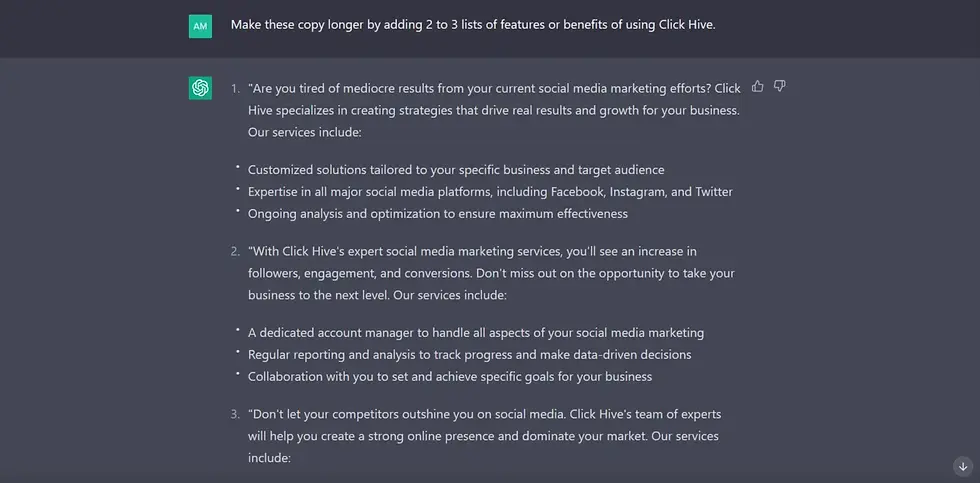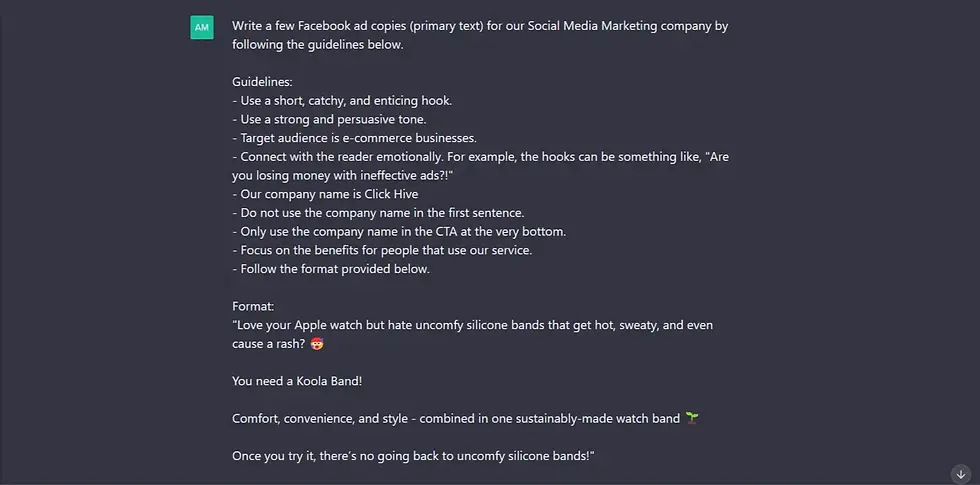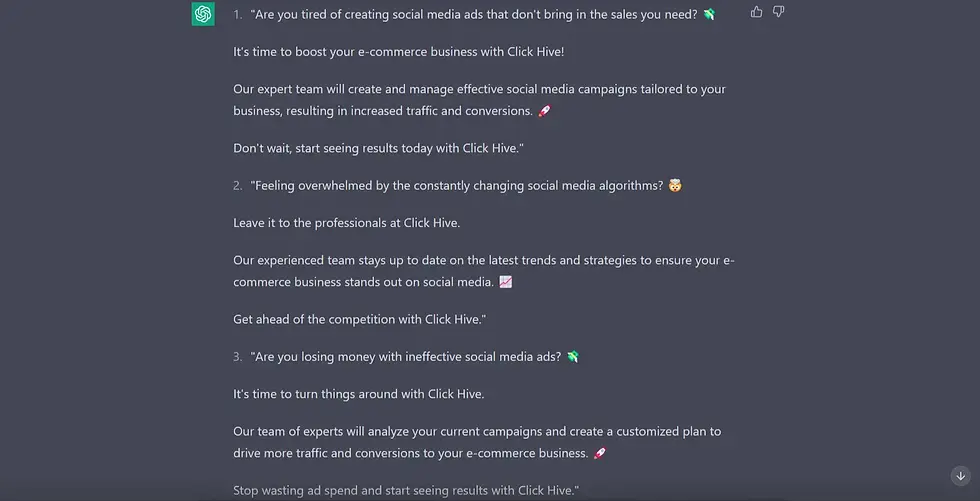
Ad copywriting is the backbone of any successful advertising campaign. It's the first thing that catches the attention of potential customers, making them want to learn more about your product or service.
But let's be real; writing ad copy can be a real pain in the butt. It's a lot of pressure to come up with something clever, witty, and to the point, all while trying to make it sound like you're not trying too hard.
But AI can help make ad copywriting a breeze. And I'm here to give you the ultimate guide to harnessing the power of AI in ad copywriting.
Towards the end of 2022, we saw a lot of AI tools forge into existence. And as we got into 2023, all these tools were updated to be as good as, if not better, than human talent!
Before we get into the core of this blog post, it would be great if we collected some background knowledge on ad copywriting and AI. Let's dive into that.
What Is Ad Copywriting?

It's like a secret language spoken only by Madison Avenue executives and Mad Men characters, but the truth is, ad copy is an essential element of any marketing strategy.
Just like how graphic-rich images and UGCs work for brands, copywriting is the art and science of crafting persuasive and compelling messages to promote products, services, or ideas.
It is basically the written content that is used in advertisements such as billboards or online ads.
It combines creativity and strategy, where everything comes down to understanding the target audience, identifying their needs and desires, and crafting a message that speaks to them and addresses their pain points.
While ad copywriting is the process of creating a persuasive message, an ad copy, or a sales copy, is the product it creates.
How To Write an Ad Copy?
Ad copy is the written part of an ad. It's the words that persuade, inform, or entertain the audience. Ad copy can take many forms, from a catchy tagline to a persuasive product description, with words that convince people to click "buy," "subscribe," "learn more," etc.
See the example of an ad copy displayed below.

But how do you write ad copy? The truth is, anyone can write it. But it takes effort and great skills to craft something that actually works.
1. Research and Understand the Target Audience
When writing an ad copy, the first step is always research. You need to understand your target audience:
Who they are.
What they need.
What they want.
This means identifying their demographics, psychographics, and even their pain points. Once you know who you're talking to, you can craft a message that speaks directly to them.
And let's be real, if you don't know who you're talking to, you might as well be shouting into the void.
2. Address Their Pain Points
Once you've identified your target audience, it's time to address their pain points. This means identifying their problems or concerns and crafting a message that offers a solution.
For example, if your target audience is people with back pain, your ad copy could highlight the benefits of your product for relieving back pain.
By addressing their pain points, you'll show that you understand their problems and that your product is the solution they've been looking for.
Have a look at the example below.

3. Persuasion and Benefits
After addressing your target audience's pain points, the next step is to persuade them to take action.
When writing the copy, highlight the benefits of your product or service and address any potential objections they may have.
For example, if your product is more expensive than the competition, your ad copy could highlight the added value of your product.
Always remember that ad copy aims to convince your audience that your product or service is the best option for them.
4. Humor and Entertainment
Humor can be a powerful tool in ad copywriting as long as it's done right. People love to laugh, and if you can make them chuckle while getting your message across, you're more likely to make an impact.
But be careful, though. Humor can be tricky, and if it falls flat, it can actually do more harm than good. Some people have a knack for humor. If you're not good with it, the best thing is not to force it into your copy.
Also, before you add a pun or joke to your ad, ensure it's appropriate for your target audience.
5. Alignment With Branding and Messaging
Your ad copy should be aligned with your company's overall branding and messaging. This means using the same tone, language, and imagery that you use in your other marketing materials.
This consistency will help to build trust and recognition with your target audience. Plus, it makes it easier for them to identify your brand and remember your message.
6. Make It Clear and Concise
People's attention spans are shorter than ever, and if you can't get your message across quickly and effectively, you're likely to lose them.
When it comes to ad copywriting, less is often more, better, and more effective. So, keep your ad copy clear, concise, and to the point. Use simple language and avoid jargon, technical terms, or buzzwords that might confuse your audience.
However, there are instances when a long, story-driven ad copy performs better. That's why it's essential to know the different types of copywriting, as they all have their own ideal length and format to aid in their purpose.
Best Different Types of Ad Copy
1. Storytelling-based Ad Copy

This is the ideal format of ad copy to connect with your audience on an emotional level. By crafting a story that resonates with them, you can create an emotional connection that will make them more likely to take action.
For example, if you're selling a weight loss product, you could tell the story of a person who struggled with weight loss but was able to achieve their goals with your product. Not only does this make your product more relatable, but it also makes it more memorable.
2. Question-based Ad Copy

Question-based ad copy is a great way to get your audience thinking and engaging with your message. Asking a question that resonates with them can make them more likely to take action.
If you're selling a financial planning service, you could ask, "Are you worried about your financial future?" This question will make your audience think about their own financial worries and make them more likely to read more or take action and seek out your services.
3. Benefit-based Ad Copy

People don't buy products or services for the sake of buying them; they buy them because they will benefit from them in some way.
Think about how a certain product or service will benefit you. A wallet lets you keep your money and cards organized and in one place inside your pockets. It's a solution for people that carry money around. It benefits such people.
Instead of just listing the features of a product, it focuses on how those features will benefit the consumer. That means instead of just saying that a car has a fuel-efficient engine, a benefit-based ad would say, "Save money on gas with our fuel-efficient engine."
4. Feature-based Ad Copy

A feature-based ad copy focuses mostly on the company that's advertising. Oftentimes, such copy lists down the features of a product or service.
The goal here is to showcase what you've got and why it's better than the competition. For example, if you're selling a car, a feature-based ad copy would list down the car's features, such as its advanced technology, safety ratings, fuel efficiency, and so on.
What Is Artificial Intelligence (AI)?

AI, or Artificial Intelligence, is one of the buzziest buzzwords today. But what exactly is it, and why should you care?
Essentially, AI is the simulation of human intelligence in machines programmed to think and learn like humans. The idea of creating machines that can think and learn like humans has been around since the 1950s. But it's only in recent years that technology has advanced enough to make significant strides in AI development.
AI is already affecting our daily lives in ways you might not even realize. AI is everywhere, from virtual assistants on our smartphones to recommendation algorithms on streaming services. And as technology continues to advance, it will only become more integrated into our lives.
What Is GPT?

If you're no stranger to the internet, you'd know how people are going crazy over AI that can write creatively. You might've even heard about ChatGPT.
ChatGPT is basically a chatbot built on top of GPT-3. Generative Pre-trained Transformer (GPT) is a language model developed by OpenAI. It kept improving over the years, and the latest version of GPT is GPT-3.
GPT-3 has been trained on a massive dataset of internet text, and it can generate human-like text based on a given prompt. This includes essays, articles, poems, stories, and even computer code. The technology is already being used to create chatbots, language translators, and even entire websites.
So far, GPT-3 is more than just a buzzword. It's a rapidly advancing technology that is already affecting many of our daily lives. And OpenAI is already working on enhanced versions of GPT. For example, the GPT-4. If GPT-3 has caused such a revolution, it's beyond our imagination how bigger GPT-4 will be!
How Can AI Help in Ad Copywriting?
You may be aware of the capabilities of ChatGPT. Interacting with it feels just like talking to a real person with deep knowledge of everything around.
As far as we know, ChatGPT has provided the best results when it comes to AI-generated content. There are other tools like Jasper and Copy.ai, which are actually built on top of GPT but have yet to entirely create results as good as ChatGPT.
Let's say your head's stuck, and you have difficulty coming up with a new ad copy. You can go to one of the AI tools, give it some background on the ad copy you want to create, and wait for it to do wonders for you.
Let's take a closer look at how it's done.
Using AI To Write Ad Copy
Let's say you need to create an FB ad copy (primary text) for our company, Click Hive. Go to an AI tool (we suggest ChatGPT for now), and give it a prompt that briefly explains what you need it to create, and some data or guidelines that the tool can use for the copy.
Example #1
Here, we asked ChatGPT to create some ad copies by providing it with a few guidelines to follow. The below figure tells you the result we got.

Although we wanted each copy to be 5 sentences long, the AI failed to follow that specific instruction. Everything else was followed pretty accurately. So we decided to give another prompt directing the AI to add a few lists of features or benefits of Click Hive.
Essentially, the goal here is to make the copy longer with more valuable information that will drive the reader’s desires. Here’s what we got now.

We gave the AI a choice to write either the features or benefits. It chose to add the features of Click Hive. ChatGPT wrote these features out of its own judgment and creativity.
The features weren’t making the cut, so we changed our minds and decided to swap them with the benefits of using our service. And as you can see below, the results this time were right on point!

This marks a good foundation for any copywriter. With a little bit of manual tweaking (trimming down the sentences and adding a CTA), this AI-generated copy is ready to go live on Facebook.
I mean, just think about it. We crafted 5 really good drafts in just 10 minutes. Imagine how this could accelerate your work!
Example #2
Let’s take a look at another example of us using AI to write ad copy. This time, we decided to create a different format. So we gave the AI tool a more detailed list of guidelines. In addition, we also provided it with one of the ad copies we wrote for one of our clients as a reference for the format we want it to follow.
This is what the prompt looks like.

And the result we got:

It even identified and added suitable emojis to the copy. That’s three great pieces of ad copy drafts created in under 7 minutes. And it requires minimal manual tweaking than the pieces we created in the previous example. Mind-blowing, isn’t it?!
Key Takeaways From the Examples
The more concise and definitive your prompts are, the better will be the AI-generated results.
Most of the time, these AI-generated content will require some level of manual tweaking from a human. But you’ll have a really good base to start with.
AI sometimes fails to follow instructions. If you find it struggling to follow an instruction, rewrite/rephrase it and make it more concise and digestible for the machine.
AI does an impressive job of following patterns. If you have a specific example or format you want it to inspire from, feed it.
Assuming that you now have a good idea of how AI works and how you can use it to create ad copy, feel free to head over to an AI tool and play around with it yourself.
Experimentation is key. As you play around with AI, you’ll eventually figure out the working formulas for writing winning ad copy.
3 Challenges of Using AI in Ad Copywriting

We’ve identified the sweetness of using AI. It’s good, it helps, and it’s been a game-changer for us so far. But what about the downsides of it?
It sure does come with a few challenges, and it’s time for us to explore the other side of AI and figure out the weak points.
1. Mind the Facts
One of the biggest challenges of using AI in ad copywriting is the risk of generating inaccurate factual content. After all, the machine is only as good as the data it's fed. And if that data is inaccurate or out of date, the AI's output will be too.
ChatGPT, or any other AI, is only trained on data collected until 2021. If you ask it for anything that happened after 2021, chances are, it’ll produce the wrong content.
AI basically works by filling in the blanks. So it’s “predicting” word after word based on the data it has. So although it might have answers to most of the things you ask it to do, be aware that it could be factually incorrect.
This is a major problem when it comes to sensitive topics like healthcare or finance.
2. Don’t Expect Perfection
Another challenge of AI in ad copy is that it's not perfect. Sure, the machine can crank out a lot of copy quickly, but it's not going to be as good as something written by a human. The AI might miss nuances or not understand the context of the copy. And there’s only so much that you, as a user, can feed it.
It might also fail to follow certain instructions, or the output might not be in the tone of a business you want the ad copy for.
And as evident from the examples we came through, manual tweaking, most of the time, is necessary.
So, while AI can be a great tool for generating ad copy, don't expect it to replace human copywriters entirely. It’s a tool that helps, so the best advice is not to put faith in it blindly.
3. Identifying the right prompt for your needs will take some trial and error
You want the AI to understand what you're trying to say, but you also want to give it enough room to be creative. And, of course, you want the output to align with your brand's messaging.
Finding the right balance is hard and can take some trial and error. You might have to run a few different versions of the prompt before you find the one that works best for your needs.
As we saw in the examples, we had to run a few different prompts to get the perfect draft we needed. So expect some back and forth between you and the AI.
Conclusion
AI is a great way to accelerate the production capacity of ad copy. Copywriters can leverage this technology to create ad copy 2 or 3x faster!
While AI technology has the potential to revolutionize the ad copywriting industry, there are still significant challenges to overcome. From the generation of inaccurate content to the difficulty of identifying the right prompt, there are several obstacles to consider when using AI for ad copywriting.
However, with advancements in technology and the growing use of AI in various industries, it is possible that these challenges will be overcome in the near future.
Until then, it's essential for businesses and marketers to understand the limitations of AI in ad copywriting and to approach the use of AI with caution.









Yorumlar